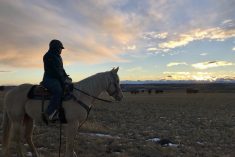My basic philosophy on business management is that even though the production component of my business is important, it needs to be dictated by economics and finances.
With that being said, most of my articles have all been about production practices. Shame on me!
I would ask you to bear with me while I touch on what was the most beneficial breakthrough my business has ever had. In 2001, I was working driving a truck long hours and struggling to keep a farm afloat.
We had no money and no time, but we decided to sell five cows in order for me to take the Ranching for Profit school. So in January of 2002, I drove to Calgary to attend the school.
Read Also

Reintroducing fire to Saskatchewan pastures
Pastures evolve over time. Woody plants and shrubs, which cattle can’t eat, may encroach on natural grasses. Invasive species, such…
I was quite good at grazing. I had excellent results with reproductive rates. My winter feeding costs were very cheap. I was bale grazing pea straw that year. I had very low death rates. I was working long hours and bringing in a good wage. I could brag about all these things. Why was I failing? Why were we broke? I did not understand the economics!
The school taught me an amazing tool that I had never even heard of before — the Gross Margin Analysis.
That was the turnaround point for my business. It showed me where my business was failing and gave me a new direction. Even if I was the best at what I was doing, it provided me with very little benefit because I was doing the wrong thing! The production practices that I was good at were the wrong ones.
Gross margin analysis allows me to dissect my business and find out where it is profitable and where it is not. By breaking my operation into profit centres, I was able to see which production practices were working and which needed to be improved, or eliminated.
Farmers complain about two things the most (other than the weather): not having enough time and not having enough money.
I have learned that the most common way producers can make more profit, is to stop doing things. Stop working on the profit centres that are dead. This also seems to free up some time to work on the parts of their business that are profitable and maybe spend some more time with the family. If a production practice is not profitable, either you fix it or you get rid of it.
Revenue versus cost
Today, I find myself frustrated when I go to local seminars. I hear two sides to the room. One side is claiming that they do a certain production practice because it gives them more revenue. The other side states that they do another production practice because it lowers their cost of production. Who is right?
Increasing your revenue tells me nothing about the profitability of your business. Neither does lowering your cost of production. What will tell me the viability of a production practice is the margin. The difference between the gross product created and the costs associated with that profit centre. If your costs increase at the same rate as the benefit it provides, what is the purpose? Or if you lower your revenue because you cheaped out on an input, are you further ahead?
A gross margin analysis is really quite simple. If you have a big number and you subtract a small number from it, you have a profit. We just do this quite a few times in all the different profit centres.
Let’s define a profit centre. It is one component of your business. You may have many profit centres that make up your farm such as cow-calf, feeder, hay, grazing and grain profit centres.
What to fix?
Each farm is unique. Hopefully, your gross product (the big number) minus your direct costs (the little number), of each profit centre gives you a positive gross margin. If not, you will know what needs to be fixed. Either the big number needs to be bigger or the small number needs to be smaller. Each profit centre can be broken down to determine the margin it creates which contributes to the total. This in turn has to cover all of your overhead costs. If it does, you have a profit.
Now this analysis has to cover all of the costs, even the non-cash costs. After you have paid for all of your labour (I despise the term “unpaid labour”) and all of your cash costs, you need to cover opportunity cost, depreciation and inflation. If you can do this, you have made a profit.
Opportunity lost
Opportunity cost is a measure of your management. Are you getting enough of a return on the assets that you are managing, or should that investment be put somewhere else? Most producers have a hard time swallowing opportunity cost. You don’t see it in your finances, but you need to account for it. Look at it as an interest charge on that investment. That money could be earning you a return somewhere else. Is it earning enough of a return as a cow or as a tractor? I like to use an opportunity cost of 10 per cent, mostly because it calculates easily. Somewhere, my money invested should be able to return me 10 per cent.
An easy way to determine your opportunity cost is use the highest interest rate you are currently paying on borrowed money. An asset could be sold and its value could pay down the loan and save you the interest charges. If your interest was eight per cent, then the opportunity cost on your assets could be eight per cent. If your credit card debt has an interest rate of 18 per cent, then your opportunity cost might be 18 per cent.
Depreciation
Depreciation is the loss in value of an asset over time. It is calculated by subtracting the salvage value of an asset from the purchase value divided by the number of years owned. Most of us think about the equipment we own when we think about depreciation. We buy a new pickup and as soon as we drive it off the lot it loses $20,000 in value.
Most of our equipment depreciates but our cows can also depreciate. The longer a cow can stay in the herd, the lower her depreciation.
Let’s just stick to covering our
depreciation for today. What would be an average depreciation value on a typical farm — 10, 15 per cent? In theory, every year, the depreciation value of an asset should be accounted for and saved for when that asset needs to be replaced. When that time comes, you use the money saved up plus the salvage value of the asset to replace it. Are you covering your depreciation each year?
Inflation can vary but let’s say an inflation rate of three per cent is average. Will the money you have today be worth the same tomorrow? Will you still pay the same for a loaf of bread 10 years from now as you do now? No, not likely so we have to make sure our businesses will be ahead of where it is today, 10 years from now by accounting for inflation in our economics.
Now include this all into your gross margin analysis and see if you are making a profit. It’s the big number minus the little number and it is amazing what that can tell you. I can’t emphasize enough the importance of a farm business understanding its economics. As sexy as the production side of your operation is, it’s the economics that makes a profit. Now this is the part where I get to offend you. If your farm business is not making a profit, it is your fault! It is not the government, or the weather, or the markets. It is your fault. You are the manager of your business and it is up to you to manage. You have the opportunity right now to improve your skills. Find somewhere that teaches a gross margin analysis and learn it. Then do it, and keep doing it. What have you got to lose? I know for a fact, that sometimes things can only get better. The more you know, the more you know you don’t know! I’d be happy to point you in the right direction.
Steve Kenyon runs Greener Pastures Grazing Management in Busby, Alta.,www.greenerpasturesgrazing.com,(780) 307-6500, email[email protected].
















